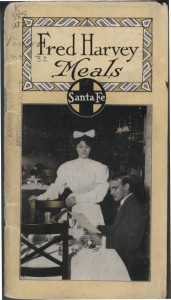
An early-20th-century pamphlet about the Harvey House restaurants along the Santa Fe railroad. Courtesy Kansas Memory.org, Kansas State Historical Society (copy and reuse restrictions apply)
There was a time when riding the rails was more than just a short trip from point A to point B. It was a journey to be enjoyed, not only for the passing scene, but also for the luxurious meals served in the diner car.
It all began in 1868, when to compete for passengers, George Pullman introduced the first dining car on the railways. It was no ordinary diner, though. Service was patterned after the finest restaurants in New York. Just to be sure, he named it the Delmonico, after the most prestigious restaurant of the times.
Dinner in the diner was more than a meal—it was an experience. There were tables for four on either side of the aisle, with large windows at each double seat so that diners could enjoy the passing scene as they ate. Each was set with snow white linens, Dresden china, and silver flatware, just as they might have been at a high-end restaurant (and incidentally, passengers were known to walk away with pieces of silver and china, just as they do in restaurants.)
Chandeliers that burned gas hung over the aisle at the location of each table. They were never lighted at full force, however, since there was the fear of fire, but that may not have been so bad, since a soft glow added to the romantic ambiance. And the service was impeccable, provided by a waiter in formal dress.
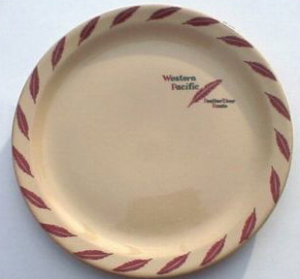
A dinner plate from Western Pacific's "Feather River Route" pattern. Photo courtesy Potrero on CollectorsWeekly.com
It wasn’t long before other railway lines followed. Like Pullman, they featured menus from famous restaurants, recipes by renown chefs and of course, elegant décor. Each railroad commissioned its own unique china and silverware patterns and took pride in the excellence of its service. With the exception of the really luxurious dining cars, most of the china was of ironstone because it was more durable than porcelain. Even then, if chips and cracks sometimes occurred, it was common practice to throw the damaged pieces out the window as the train moved along, since it was against railroad rules to serve a meal on chipped china.
Two great books on railroad dining history:
1. Dining by Rail by James D. Porterfield (St.Martin’s Griffin Press). An interesting account of railroad dining; includes recipes from the railways; and
2. First Class Travel: Legendary Train Journeys Around the World by Patrick Poivre d’Arvor (Vendome Press)
Everything was cooked to order in the kitchen, which was separated from the dining car by a tiny pantry. There were never any lingering odors of food cooking. The ventilation system was perfect. Every rail line had its own specialties: the Santa Fe had its French Toast; the Great Northern its chicken pie with the secret ingredient; the Union Pacific its prime steaks; the Texas and Pacific its cantaloupe pie; the Northern Pacific the great big baked potato, just to name a few. Most meals cost seventy-five cents in the West and one dollar in the East. And second helpings were free.
Not all meals on wheels were consumed in the luxury of a dining car. Some were gulped down in fifteen minutes or less at depot stops Sometimes the food was good and sometimes it was terrible. And it wasn’t uncommon for travelers to develop indigestion afterward. These railroad eating houses were known as “beaneries,” the waitress was the “beanery queen” and the chef was the “lizard scorcher.”
Along Came Harvey
Then there were the Harvey Houses. They were not as elegant as the dining car but rather nice restaurants created to service passengers at depot stops. Gentlemen were expected to wear coats while dining, and if they did not have one, Harvey’s kept a supply of loaners on hand.
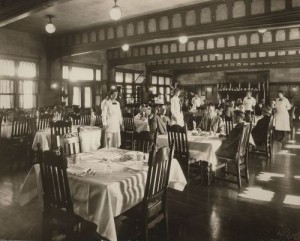
Interior of the Harvey House in Hutchinson, Kansas between 1920 and 1929. Photo courtesy KansasMemory.org, Kansas State Historical Society (copy and reuse restrictions apply)
The food was comparable to that served in fine restaurants, including vintage wines and even quail in aspic. The tables were set with fine china and linens that were hand made in Ireland of an exclusive pattern to match the china. Harveys introduced the first oversized napkins (which became standard even for dining cars) so that the gentlemen could tuck them into their waist coats.
Meals at the Harvey House were seventy-five cents with plentiful helpings. Passengers could indicate from information telegraphed ahead to the train whether they wished to order the standard seventy-five cent dinner, or order á la carte when they arrived. Those who ordered the standard menu found their first course waiting when they arrived at the restaurant. Menus were planned so that those traveling further along would not get the same meal at other Harvey Houses on the route for at least four days.
Girls! Girls! Harvey Girls!
It wasn’t just the meals that appealed to the travelers there. So, too, did the waitresses. Harvey Girls were selected to bring culture, refinement and beauty to the service.
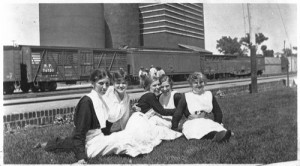
Harvey Girls on break. Photo courtesy KansasMemory.org, Kansas State Historical Society (copy and reuse restrictions apply)
They were to be of good character, attractive, and intelligent, ages 18-30. Their moral character was to be above reproach and they had to sign a contract saying that they would not marry for a year. If they did date during that year, they were fully chaperoned in the “courting parlor” of the dormitory where they lived. The Harvey Houses were not only a good place to eat, but also a good place for budding romances. You might say they were the match.com of that era.
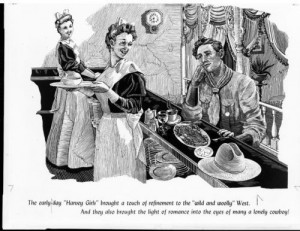
Every lonely cowboy dreamed about Harvey Girls. Courtesy KansasMemory.org, Kansas State Historical Society (copy and reuse restrictions apply)
The humorist, Will Rogers, observed that the Harvey Houses kept the West in food and wives.
So if your family’s been in the states for awhile, check your genealogy. There’s a pretty good chance you have a Harvey Girl in your family tree.
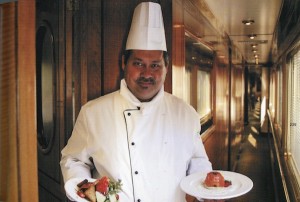
What a cool article. My wife loves dining out but won’t ride the train for distance, because of the food.
Nice to know there was a time …
Great Story Satenig! I highly recommend “Rising from The Rails” for others who are interested in this subject. Read the book or watch the DVD or just hit the web-site.
It’s the story of the Pullman porters and an important piece of African American history.
Happy eating everyone!
Great article! I’ve heard that some modest attempts have been made to re-combine luxury dining and train travel recently, such as in the Cape Cod area. Does anyone know about that?
From Satenig (author): There is a site on Google (luxury railroad dining) that describes the World’s Top 25 Luxury Trains and some fascinating trips. The one that appeals to me the most is the VSOE–Venice Simplon-Orient Express with restored vintage cars from the 1920s. It is considered the world’s most authentic luxury train.